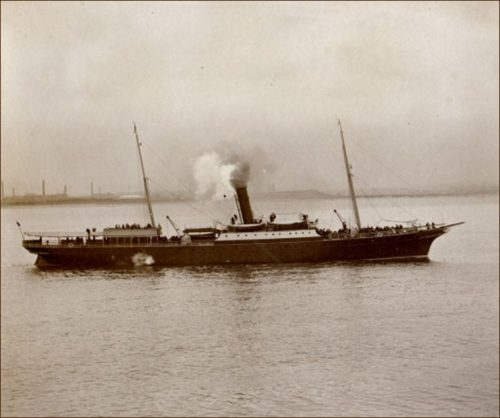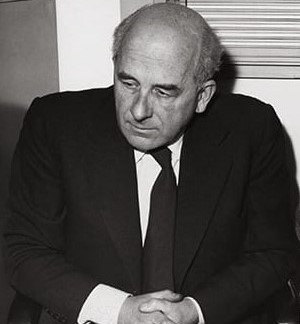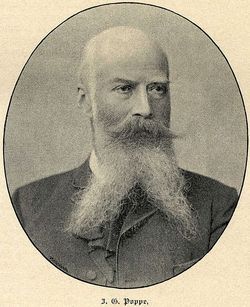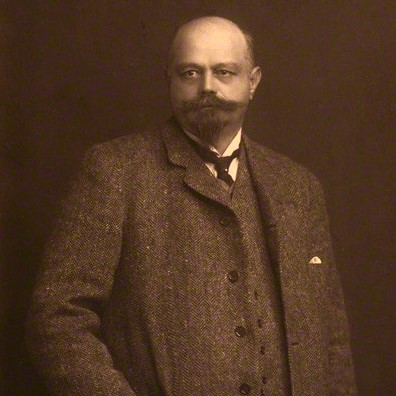The world’s first purpose-built cruise ship
The earliest recorded cruise was an around the world voyage by sailing ship in 1845 that was promoted by the Hamburg shipowner Rob M Sloman. Thomas Cooke later organized so called excursions, cruises to the Mediterranean where passengers often stayed in hotels during their stay in port. See the chapter History of cruising where I give an overview of how cruising has developed over the years. The first shipping company to initiate a series of cruises with their own ships was the The North of Scotland & Orkney & Shetland Steam Navigation Company, or North Company as they were more conveniently known. North Company had started operations after a merger in 1873 of older Scottish shipping companies.
The Scotsman newspaper of 8 June 1886 the North Company showed an announcement stating that “the fast and commodious steamship St. Rognvald, is intended to make a special trip with a limited number of cabin passengers on Thursday, June 24 from Leith and Aberdeen to Bergen and some of the principal fjords and places of interest on the west coast of Norway.” This was in fact one of the first attempts to start a scheduled cruise service.

In the next two weeks between the advertisement and start of the voyage, no less than 90 passengers made reservations. This was far more than expected and quickly a second cruise was planned which soon sold out as well. That summer three more trips were scheduled.
North Company directors, seeing that this formula of short inexpensive cruises was a huge success, decided that the company needed to act fast to capitalize on its success and a new ship was ordered from Hall Russell of Aberdeen for delivery in time for the 1887 season.
The original ship starting the new cruise service, the 984 grt, St. Rognvald (named after the Earl of Orkney) was an iron hulled single screw coastal passenger steamer also built by Hall Russel & Co in 1883, at the time the North Company’s largest ship. By today’s standards she was a small vessel with rather spartan interiors, as 104 guests only had four toilets and 11 washbasins at their disposal. But at the time, she was regarded quite an impressive ship with more than adequate facilities.

St. Rognvald’s successor, the St. Sunniva is regarded to be the world’s first dedicated cruise ship. She was named after an Irish princess who fled to Norway being on the run for a heathen king who wanted to force her into marriage. Together with some servants she hid in a cave at the Norwegian coast which was sealed of by a landslide. When the king’s troops searching for her arrived, they were too late. St. Sunniva‘s exterior was designed to resemble a classic steam yacht. She was an iron-hulled ship of 960GRT, 236ft long and a draft of 22ft which made this small ship quite stable in the often hostile waters she sailed. Her main / dining room saloon could accommodate 142 guests in a single sitting. A deckhouse aft housed a men’s smoking room and a ladies’ lounge. The only entertainment onboard was a piano for use by her passengers.
Her passenger accommodation could be found on main deck and lower deck.: on either side of the main deck were sixteen 2-berth cabins. An additional 2-berth cabin and a 12-berth ladies cabin were placed between the outer rows of cabins. On this deck were just two bathrooms and six toilets, with an additional bathroom and two toilets for the ladies’ cabin. On the lower deck were eight 4-berth cabins aft and finally just ahead of the engine room two 4- berth and four 6-berth cabins sharing just one bathroom. The only available toilets were on Main deck.
St. Sunniva only operated during the summer and was laid up in winter. The venture was such a success that once again St. Rognvald was pulled from her regular ferry services she had returned to, to help accommodate the large number of bookings. On these cruises St. Rognvald with its far more simple interiors than St. Sunniva now only carried 50 passengers.

To be able to offer a more diverse cruise program, the North Company added voyages to more far away destinations, like the Baltic, round Britain and even the Mediterranean to be able to expand operations into the winter.
Because St. Rognvald was originally a ferry and in between cruises still operated as such, it was decided she needed to be upgraded to match the standards of St. Sunniva. This took place in the winter of 1890 – 1891. Cargo space was changed into additional two berth cabins and two bathrooms plus two more toilets were added.
North Lines successful cruise activities did not go unnoticed by its rivals. Soon after St Rognvald‘s first successful cruise to Norway the Wilson Line from Hull launched their own cruise operations, but their small ships could not match St. Rognvald, let alone St. Sunniva’s interiors. Orient Steam Navigation Co. Ltd entered the market in the summer of 1889 with two of their Australian mail service ships, Chimborazo and Garonne. Measuring 3847 GT and 3876 GT respectively, with a capacity of around 150 passengers and both with powerful 3,000hp engines they posed a bigger problem. They were normally used in a two-week liner service from London to Australia, but the intense heat during their voyages during the summer meant passengers tried to avoid these sailings. So Orient decided to try their luck in the profitable cruise service. Garonne was the first to be sent on a cruise to Norway. It proved to be a great success, and Garonne’s more luxuriously appointed interiors were immediately popular with travellers. Orient decided to focus more on cruising and of course other liner companies were now becoming interested as well.

A couple of years later, in 1900 also P&O, Royal Mail, French Line, North German Lloyd and HAPAG sent their ships cruising, also in Scandinavian waters. During the winter of 1990/1991 HAPAG took delivery of their newbuilding Prinzessin Victoria Luise, the first purpose-built large cruise ship, measuring 4,409GRT. She provided sumptuous accommodations for 180 passengers. In 1904 P&O converted their 1881 mail liner Rome into the cruise ship Vectis. She was a ship of 5,545 grt but carried just 150 passengers. These ships were in another league than the North Company’s little ships which were yacht-sized.
To make matters worse Thomas Cook had joined forces with the Norwegian Hurtigruten coastal service company and this proved to be very successful. All this meant the North Company and its smaller ships was completely outclassed and the saw their profit margins all but disappear in a very short time.

Then disaster struck when in the winter of 1900, St. Rognvald was wrecked on Burgh Head, Stronsay, Orkney during her customary winter ferry services. There were no casualties, but the ship was lost. Because of the situation with new competitors arriving at the scene constantly, North Company decided to replace her with a new ferry, but one without cruise standard interiors and facilities. They just didn’t have the means to compete with the big companies and their huge budgets to compete in the cruise market. A market which demanded more sophisticated and luxurious tonnage by the year, while North Company offered yacht cruising on rather simple vessels.
And soon, the North Company also reduced the number of St. Sunniva’s cruise sailings. She was entirely withdrawn from the cruise market in August 1908. She had soldiered on for 21 years in cruise service.
Her lower deck accommodation was removed and substituted with cargo holds while her main deck accommodation was extensively rebuilt for ferry service. Finally her superstructure was extended to enlarge her passenger carrying capacity.
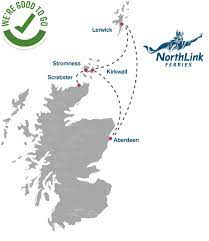
From now on, St. Sunniva was operated purely as a ferry on a weekly service from Leith and Aberdeen. Alas, on April 10, 1930, in a dense fog, she ran aground on the small uninhabited island of Mousa. There were no casualties, but St. Sunniva was a total loss.
The North Company remained an independent ferry company until taken over by the Coast Line Group in 1961. Coast Line sold the North Company and its routes to P&O Ferries in 1971 which operated as P&O Ferries -Orkney and Shetlands Services until 2002 when P&O Ferries lost their concession. The name St. Sunniva was carried by successive ships operating on the route during P&O operations. Today the North Link Company, a joint venture between Caledonian MacBrayne and the Royal Bank of Scotland operates these northern ferry links to Orkney and Shetland with 3 ferries and two freighters/livestock carriers, non of them carriyng the famous name St. Sunniva anymore….
